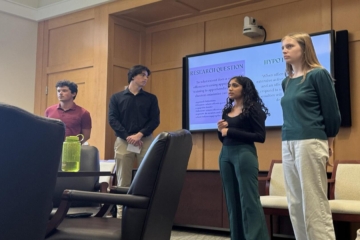Students present gun policy solutions in innovative course
Most public policy classes at William & Mary focus on institutions, processes or methods behind creating specific policies. But Assistant Teaching Professor Alan Kennedy took a new approach with his Gun Policy and the Second Amendment seminar: producing research that can be useful to policymakers.
Students in Kennedy’s fall 2024 class conducted weeks of research and data analysis on a variety of topics related to gun violence.
Of the four groups of students, each chose a unique angle: the role of firearm access in suicide rates, partisan framing of gun violence in news media, federal background checks and domestic violence homicide rates, and alternate tactics for law enforcement in response to school shootings.
The groups presented their findings at the end of the semester during a “Gun Policy Summit” in their class, voicing potential solutions to better address gun violence. William & Mary Police joined the summit, with Kennedy aiming to expand participation to organizations involved in gun violence prevention as the course gains credibility in the field.
Firearms and suicide rates
To see if there was any correlation between state firearm access and suicide rates, one group examined red flag laws, background checks, waiting periods on gun purchases and safe-storage requirements in all 50 states from the most recent data. Findings showed that suicide rates were moderately lower in states with more restrictions than in those with fewer restrictions. To better examine confounding variables, students recommended further research on differences in mental health support across states and the number of firearms trafficked across state lines.
Partisan framing of gun violence
One group sought to examine how the political bias of broadcast news outlets affects the way mass shootings are framed. Examining MSNBC, CNN, BBC, Fox News and Newsmax on a left-to-right-leaning scale, and analyzing a different shooting per outlet, students found that left-leaning outlets were more likely to focus on victims and guns used in mass shootings, while right-leaning outlets focused more on the shooter’s motives and external sources that may have incited the incident.
Federal background checks and domestic violence homicide rates
The Brady Handgun Violence Prevention Act, implemented in 1993, established background checks for any unlicensed person attempting to purchase a firearm. Students researched what impact, if any, this act had on intimate partner homicide rates, tracking data from 1983 to 2003 from the Bureau of Justice Statistics. Findings showed a slight decrease in homicide rates per capita since the introduction of the Brady Act, but student researchers noted that there was a lack of data that could’ve bolstered more detailed findings.
Different approaches to school shootings
Students examined the effect of law enforcement response tactics on casualty rates in school shootings, comparing offensive and defensive approaches, to determine how response strategies and training impact the outcomes of shootings. Students also explored how state and local policy influenced police readiness and training.
Of the 10 school shootings studied, findings showed that direct engagement with shooters resulted in fewer casualties and a shorter duration of the event. Attempts to negotiate or evacuate had higher casualties and lasted up to 156 minutes. Student researchers also found that of the states where the incidents took place, only Texas and Michigan have laws requiring active shooter training after police academy schooling, and Michigan law enforcement only needs to complete training once.

Kennedy was proud of the work each of his students did on their projects, even when there were disagreements among groups. For instance, when discussing topics as a class, there was healthy debate on how law enforcement should respond to school shootings. Regardless, the students were in agreement about gun violence and the impact it has.
“40,000 Americans die every year from gun violence,” Kennedy said. “Everyone took the class because they hope to do something about it.”
Kennedy aims to continue teaching the course, working with students to find public policy that can better address the needs of gun policy.
“It’s not enough to study gun policy,” he said. “I want to actually prevent gun violence.”
Latest W&M News
- Meadow restoration breathes life back into hidden campus treasureOver the past year, Madeline Oubre has worked closely with William & Mary Facilities Management to completely restore Melissa's Meadow, named for an alumna and located near the McCormack-Nagelsen Tennis Center.
- Sean Galloway selected as new chief financial officerSean D. Galloway is William & Mary's new chief financial officer bringing more than two decades in public, private and high education experience to the role.
- William & Mary’s Batten School & VIMS unveil Chesapeake Bay HallChesapeake Bay Hall serves as a hub for much of the lab-based science driving the institutions’ academic, research and advisory missions.
- W&M’s James Dwyer named a 2025 Guggenheim FellowWilliam & Mary Law Professor James Dwyer has been awarded a Guggenheim Fellowship as part of the foundation’s 100th class of fellows.
- Virginia’s experience with MSX aids Atlantic Canada’s aquaculture industryW&M’s Batten School & VIMS recently hosted a delegation of government officials and aquaculture industry representatives from Atlantic Canada.
- Roll with IT: Jolly wins the Duke AwardJeff Jolly, who has worked in information technology at William & Mary for 24 years, is this year's winner of the Duke Award for exceptional service.













